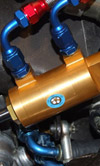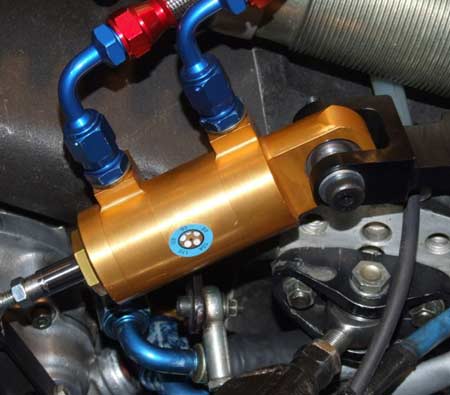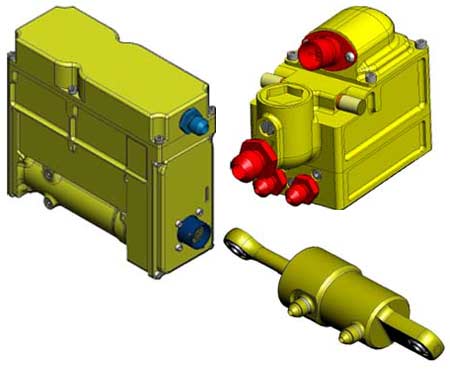Le Mans transmission
 Le Mans places abnormal demands on almost every component in a racecar, with the suspension and engine taking a relentless pounding on every lap of the 13.629 km circuit. Also subject to the same war of attrition is the gearbox and driveline. In the past, gearboxes were a regular source of problems for competitors, either thanks to simple fatigue failures of parts, or driver fatigue leading to missed gearshifts. In recent years, transmission problems have become far less commonplace; this has been thanks to a number of improvements in gearbox design, materials technology and gearshift systems.
Le Mans places abnormal demands on almost every component in a racecar, with the suspension and engine taking a relentless pounding on every lap of the 13.629 km circuit. Also subject to the same war of attrition is the gearbox and driveline. In the past, gearboxes were a regular source of problems for competitors, either thanks to simple fatigue failures of parts, or driver fatigue leading to missed gearshifts. In recent years, transmission problems have become far less commonplace; this has been thanks to a number of improvements in gearbox design, materials technology and gearshift systems.
Of these the key development has been the appearance of semi-automated shift systems that do not rely on the driver for accuracy. A driver can never be 100% consistent in the way that they select a gear, and this places incredible strain on the teeth of dog engagement gears. In the 1980s, Porsche tried to address this problem - with, it has to be said, considerable success - through the use of synchromesh engagement on its sportscar gearboxes. But while this prolonged the life of the gear sets, it also increased the shift duration which, if added up over a 24-hour race distance, accounted for a considerable quantity of lost time.
It was not until the advent of pneumatic shift systems in the late 1990s that truly reliable operation of dog engagement gearboxes was possible, with the advances in sensor and computing technology making their operation practical. As with many things in motorsport, pneumatic shifters originated in Formula One, with McLaren experimenting with systems in the early '90s. However, these systems relied on high levels of air pressure, in the region of 100 bar, which not only made sealing and reliable operation an issue but meant consuming a sizeable quantity of power to generating these pressures. That was until Tyrell made a breakthrough by developing a system that operated at far more manageable pressures of 8-10 bar.

Most pneumatic shifters consist of four main components - an electronic control unit, a valve block, a shift actuator and hand controls for the driver. The most important component is the control unit, often referred to as the GCU. This interfaces with a number of gear position sensors within the transmission and with the car's ECU, and controls operations such as throttle blipping and actuation of the shift mechanism. The relatively low operating pressure of the system means that sufficient air pressure can be maintained with only a small compressor, which is often housed either in the GCU or, in some cases, incorporated into the gearbox.
The final part of the jigsaw is the driver controls, which invariably consist of two paddles mounted on the steering wheel, one controlling upshifts and the other downshifts.

Electronic systems are also available that replace pneumatics with an electrically operated shift actuator. The control side of the system works in an identical fashion to a pneumatic unit, relying on a combination of input data from gearbox, chassis and engine sensors. However, the actual movement of the gear shifter is completed by a push/pull electrical solenoid, powered by a high-voltage supply from the system's controller. The system can also accommodate non fly-by-wire throttle systems, with a separate solenoid controlling the throttle shaft to initiate a 'blip' on downshifts.
The improvements in shift systems probably represent the biggest single factor in increasing the life of a transmission. The biggest risk to a transmission is incorrect meshing of the gear dogs, a problem that semi-automatic shifters almost eliminate. No system is infallible though, and this was highlighted during the 2011 race when the shift system on the Robertson Racing Ford GT, competing in the GTE Am category, failed. The incident proved an invaluable lesson in the benefits of having a back-up system, as fortunately the original, lever-operated sequential shift system had been left in place and some quick thinking by the pit crew saw the paddle shifter disconnected and the traditional set-up reinstated.
Fig. 1 - A pneumatic shift actuator installed in a Lola chassis (Courtesy of Geartronics)
Fig. 2 - The components that make up a pneumatic shift system - the GCU with internal compressor, shift actuator and valve block. (Credit: Megaline)
Written by Lawrence Butcher